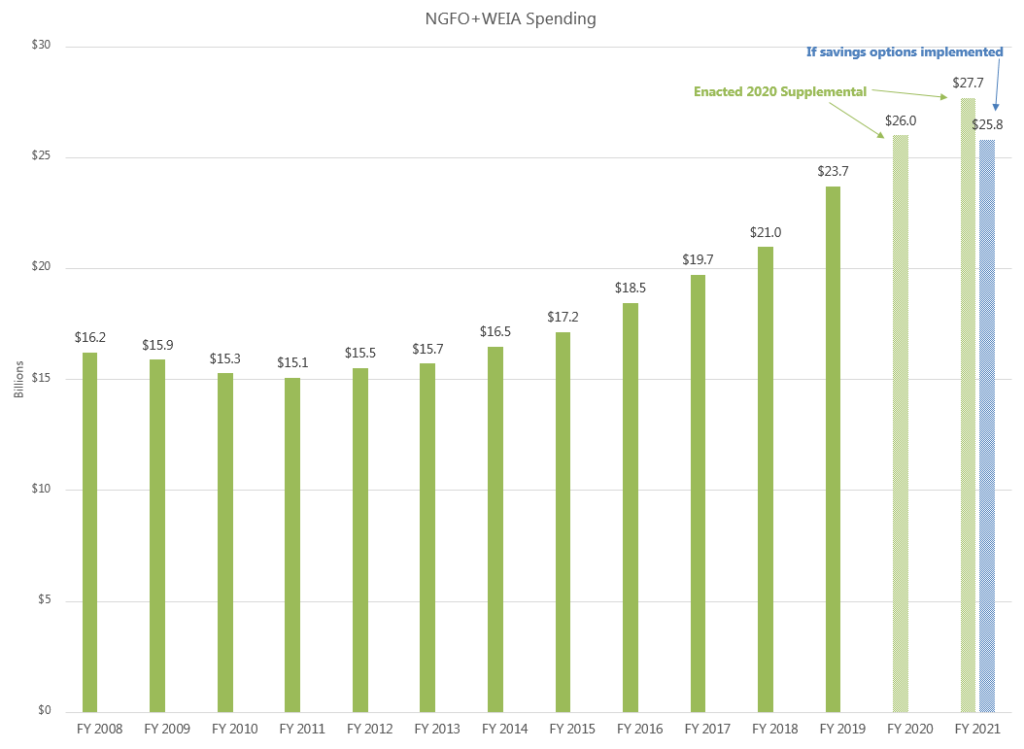1:23 pm
June 12, 2020
A month ago, the Office of Financial Management (OFM) asked state agencies to identify savings for FY 2021. This is just an exercise; the governor is not implementing or proposing across-the-board cuts at this time.
OFM identified a statewide savings target of $1.874 billion from funds subject to the outlook (NGFO; it includes the general fund–state, education legacy trust account, and opportunity pathways account). That’s 6.8 percent of the FY 2021 NGFO budget. OFM excluded K–12 basic education, bond retirement and interest, contributions to retirement systems, and the legislative and judicial budget areas from this exercise. So, to reach the $1.874 billion target, the remaining agencies were asked to find savings of 15 percent.
A 15 percent cut would be significant for any single agency, and many worthy programs might be on the cutting table. However, it’s important to keep in mind the substantial recent growth in state spending. In most cases, the cuts would put agencies’ budgets back just to their FY 2019 or 2020 levels. Statewide, if the $1.874 billion were cut from the FY 2021 budget, NGFO appropriations would be $25.540 billion (1.4 percent below FY 2020 but still 7.7 percent above FY 2019).
Consider, too, that the workforce education investment account (WEIA) will be included in the NGFO beginning in FY 2021. Including those funds, if the $1.874 billion in cuts are adopted, FY 2021 appropriations would be $25.820 billion (0.7 percent below FY 2020 and 8.9 percent above FY 2019).

Many of the agencies have responded. Some notable points:
- Several agencies (including the Department of Corrections) would eliminate the 3 percent cost-of-living adjustments that go into effect on July 1.
- Many agencies would lay off or furlough staff.
- The response from the University of Washington notes that it “does not have the tuition price or enrollment flexibility to increase revenue that it did during the Great Recession.”
- According to the Student Achievement Council, a 15 percent reduction would require cutting the Washington College Grant by $52.1 million.
- The State Parks and Recreation Commission notes that it is already facing a $19 million reduction in earned revenue, and that it has already reduced spending by $8 million.
- The Health Care Authority (HCA) would save $90.8 million by cutting optional Medicaid benefits.
- The Department of Social and Health Services (DSHS) would reduce eligibility for home and community services and nursing homes to save $107.1 million; close wards at Western State Hospital to save $34.6 million; and reduce provider rates to save $34.7 million.
- The Department of Children, Youth, and Families would use an alternate fund source for the child care rate increase that was enacted this year, reduce Early Childhood Education and Assistance Program (ECEAP) expansion slots, and eliminate the new complex needs ECEAP rate that was enacted this year.
On the 3 percent raises for state employees: Renegotiating them is something that Senate Republicans proposed recently. For Crosscut, Melissa Santos writes that renegotiating collective bargaining agreements to cancel that raise would save about $62 million in FY 2021 (cancelling the raises for non-represented employees would save another $51 million). This could be done under state law (RCW 41.80.010(5)):
If, after the compensation and fringe benefit provisions of an agreement are approved by the legislature, a significant revenue shortfall occurs resulting in reduced appropriations, as declared by proclamation of the governor or by resolution of the legislature, both parties shall immediately enter into collective bargaining for a mutually agreed upon modification of the agreement.
As David Schumacher of OFM notes in the Crosscut story, the Legislature has not yet actually reduced appropriations. Notably, although the cost of these raises is small compared to the overall budget, many agencies are proposing cutting them as a way to reach their savings targets.
Finally, I wrote yesterday that I haven’t seen any information from the state as to how much federal funding the state is getting from the enhanced federal medical assistance percentage (FMAP) under one of the federal aid bills. The responses to OFM from HCA and DSHS include early (and incomplete) estimates. It’s complicated because the amount of federal funds will increase as Medicaid caseloads increase.
The HCA response notes, “We do not have the full impact of the caseload change due to switching to the enhanced FMAP. It started effective January 2020, there would be no caseload impact until March or April. So we can realize the savings the amount from Jan ‐ March.” The HCA estimates that the enhanced FMAP for those three months increased federal funding for Washington by $135 million. Meanwhile, DSHS estimates it will receive $52.0 million from the enhanced FMAP.
Categories: Budget.